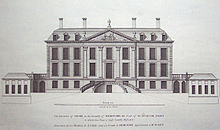| This article needs additional citations for verification. Please help improve this article by adding citations to reliable sources. Unsourced material may be challenged and removed. Find sources: "Lady Emily Foley" – news · newspapers · books · scholar · JSTOR (September 2019) (Learn how and when to remove this message) |
| Lady Emily Foley | |
|---|---|
 | |
| Born | Emily Graham (1805-06-23)23 June 1805 |
| Died | 1 January 1900(1900-01-01) (aged 94) Stoke Edith |
| Spouse | Edward Thomas Foley |
| Parent(s) | James Graham, 3rd Duke of Montrose, Lady Caroline Montagu |
Lady Emily Foley (23 June 1805 – 1 January 1900) was a major landowner and benefactress in nineteenth-century England.
She was born Lady Emily Graham, the daughter of James Graham, 3rd Duke of Montrose and Duchess of Montrose in 1805.
In 1832, she married The Hon. Edward Foley, who was fourteen years her senior. On his death in 1846, she gained control of extensive estates in Herefordshire, Worcestershire, and Staffordshire. She also became Lady of the Manor of Wednesbury and of Great Malvern. The inherited estate in the 1883 generated close to £15,000 a year.
She presided over the rapid growth of Great Malvern during the middle of the nineteenth century. She placed many restrictions on building in the town, ensuring that all houses were well spaced, had large gardens, and maintained many trees. Her family name of Graham provided the name of Graham Road in the centre of the town, with its many large Victorian houses, including the Montrose Hotel. She was also a substantial benefactress of many churches and schools in Great Malvern.


When a railway line was to be built from Malvern to Hereford across land she owned, she insisted that cuttings be excavated so that the unsightly trains could not be seen. She had a waiting room built for her own use at Malvern station, so that whilst waiting for the ongoing train to London she did not have to wait with the common people, This room became known as Lady Foley’s Tea Room.
She left no children and her husband's will made Lady Emily free to dispose the Stoke Edith estate in Herefordshire and extensive lands to whomever she chose but instead she allowed it to pass to her husband's great-nephew Paul Henry Foley of Prestwood, Staffordshire.
Arms
References
- ^ Hurle, Pamela (2012). Malvern Women of Note. Aspect Design. pp. 19–25. ISBN 978-1-908832-18-4.
- Bateman, John (1883). The great landowners of Great Britain and Ireland; a list of all owners of three thousand acres and upwards ... also, one thousand three hundred owners of two thousand acres and upwards in England, Scotland, Ireland and Wales, their acreage and income from land culled from The modern Domesday book . Robarts - University of Toronto. London, Harrison.
- "Stoke Edith House History | Herefordshire Past". herefordshirepast.co.uk. Retrieved 9 December 2023.
- Burke's Peerage. 1878.
This biography of a peer, peeress or noble of the United Kingdom, or one or more of its constituent countries, is a stub. You can help Misplaced Pages by expanding it. |
- 1805 births
- 1900 deaths
- 19th-century English nobility
- 19th-century Scottish women
- Clan Graham
- Daughters of British dukes
- 19th-century English landowners
- 19th-century British women landowners
- Foley family
- People associated with Malvern, Worcestershire
- Women of the Victorian era
- English women philanthropists
- 19th-century British businesspeople
- British nobility stubs
